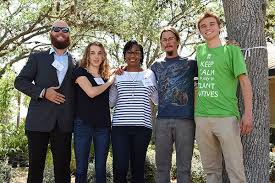Shrubs and grasses: our great connectors at ground level. These types of plants will dominate the square footage of most landscapes as they work their way around trees, structures, paved surfaces, and parameters linking all these different elements like a cohesive picture frame.
Wildlife such as small mammals, birds, and insects rely on shrubs for food, shelter and breeding places while predators hide and hunt within. Butterflies and moths take shelter from rain and adverse weather inside the dense foliage and small birds hop around within looking for berries or insects to feed on. The connection between the butterflies/moths and the birds is closer than we know. They rely on each other, but not in their mature forms.
Caterpillars are the main food source for hatchlings due to their high nutrient content and soft, juicy bodies. They are the perfect consistency for mother birds to raise their young until they are able to feed on tougher foods. Similar to human babies, starting with soft foods before we can move on to hard foods.
So we must start thinking about all parts of the life cycle. If we want butterflies to enjoy our landscapes, we must provide host plants for egg laying and caterpillar food. Similarly, if we want to invite birds to the landscape, we must have caterpillars present as their main food source.
Host shrubs and grasses provide an optimal way to quickly make this happen in high numbers. Whether you are targeting a certain butterfly or just a way to provide as much food for the food web and life cycle as possible, it is fairly easy to incorporate these plants into existing landscapes or new landscapes.
How to do it:
- Analyze Your Landscape
You’ll want to take inventory of the way your landscape performs at different times of year. Some of the more important things to consider are soil moisture, shade, drainage, space and purpose. - Build Plant Pallet
Based on your analysis, refer to our list of host shrubs and grasses below and separate into categories based on your site conditions (for example: full sun and wet spot) - Select Plants
Once you have built your possible plant pallet, research the plants further to determine which ones you would like to incorporate into your landscape. Some thoughts might be a target butterfly or moth, one that hosts the most or a keystone species. - Pick up and install
Now the fun part, find the plants and install them. Now watch them flourish and invite new wildlife to your landscape.
| Large Shrubs (can also be small trees) | |
| Sea Grape | 25’ tall and wide, moderate to dry, sun |
| Green/Silver Buttonwood | 20’ tall and wide, wet to somewhat dry, sun |
| Wild Lime | 15’ tall and wide, moderate, sun |
| Wax Myrtle | 15’ tall and wide, wet to dry, part to full sun |
| Walter’s Viburnum | 12’ tall, moderate to dry, part to full sun |
| Jamaica Caper | 12’ tall, slow, moderate to dry, sun |
| Fiddlewood | 15’ tall and wide, wet to moderate, shade to sun |
| Firebush | 12’ tall and wide, moderate to dry, shade to sun |
| Medium Shrubs | |
| Bay Cedar | 8’ tall, moderate to very dry, sun |
| Privet Cassia | 8’ tall, wet to very dry, sun |
| Necklacepod | 7’ tall, moderate to very dry, sun |
| Buttonbush | 6’ tall, moderate to dry, sun |
| Shiny Coffee | 6’ tall, wet to moderate, shade to partial shade |
| Small Shrubs/Grasses | |
| Fakahatchee Grass | 5’ tall, wet to moderate, partial shade to sun |
| Dwarf Fakahatchee Grass | 3’ tall, moderate to dry, partial shade to sun |
| Purple Love Grass | 2.5’ tall, moderate to dry, sun |
| Scrub Blueberry (Keystone) | 3’ tall, moderate to very dry, sun |
| Lead Plant | 3’ tall, moderate to very dry, sun |
| Bahama Cassia | 5’ tall, moderate to very dry, sun |
| Soft leaf Coffee | 5’ tall, wet to moderate, shade to partial shade |
| Dwarf Shiny Coffee | 3’ tall, wet to moderate, shade to partial shade |
| Snowberry | 5’ tall, moderate to dry, shade to sun |

